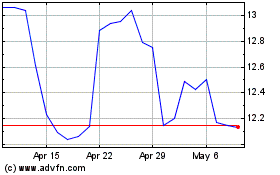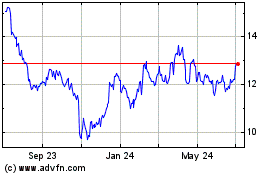Ford Says Rise in Labor Costs Will Be Less Than Inflation -- Update
November 30 2015 - 5:38PM
Dow Jones News
By Christina Rogers
Ford Motor Co. said a new union deal will have minimal impact on
profitability, projecting labor costs will grow less than inflation
and the pace of hiring will slow in the domestic auto industry as
more temporary workers are used and outsourcing becomes more
common.
Ford executives, speaking during a conference call on Monday,
said costs for workers represented by the United Auto Workers will
rise less than 1.5% annually through 2019, including a $600 million
charge booked in the fourth quarter to cover $10,000 signing
bonuses. Still, Ford's average hourly labor costs will be about $8
to $10 higher than at U.S. factories owned by foreign rivals.
Covering 52,900 U.S. hourly workers, the agreement delivers
higher pay, an end to a controversial two-tier pay structure and
hefty profit-sharing and other bonuses.
The No. 2 U.S. auto maker said the new deal offers flexibility
on costs, pointing to why the company and its Detroit rivals agreed
to auto-workers contracts that the UAW initially billed as being
among the richest in history.
Ford will use significantly more lower-paid temporary workers
and schedule more mandatory overtime, executives said, moves to
reduce the need for expensive full-time employees being added to
the payroll.
General Motors Co. and Fiat Chrysler Automobiles NV also signed
new UAW pacts in recent weeks, although neither has provided
investors with specific details on how the deals will affect
profits.
GM estimates its U.S. labor costs will remain through 2019 at
about 5% of its North American revenue, which was $101.2 billion
last year. Fiat Chrysler estimates labor costs will rise by about
$2 billion over the next four years.
Ford's hourly labor and benefit costs are expected to rise to
$60 in 2019 with the new contract, up from $57 under the prior
agreement, according to a joint forecast provided by Kristin
Dziczek and Art Schwartz, president of consultants Labor &
Economics Associates. That's far above Toyota Motor Corp.'s average
U.S. labor rate of $48 an hour.
GM's hourly labor cost will rise to $60 from $55 over the next
four years, the researchers estimate. Fiat Chrysler will see the
biggest jump in average hourly labor costs, rising to $56 from $47
over the next four years.
After years of granting concessions or holding the line on
wages, the UAW this year pushed for terms that likely will cap
Detroit companies' ability to hire and potentially lead to more
sourcing of factory work outside the U.S.
Ford, for instance, said the agreements give more flexibility to
move production outside the U.S., indicating more small-car
manufacturing will relocate to lower-cost countries like
Mexico.
Such moves could generate significant savings with Mexico's
labor costs being about one-fifth of the wages auto workers earn in
the U.S., according to labor experts. "We're not restricted from
sourcing products anywhere in the Ford world," Chief Executive Mark
Fields said.
U.S. auto sales are tracking near-record levels amid low
gasoline prices and favorable economic conditions, leading to high
production-capacity utilization rates and low inventories. If
demand sags, Ford said the cost of laying off workers is lower than
it once was, making it easier to downsize.
The contract won't "break the bank," RBC Capital Markets analyst
Joseph Spak said in a note to investors. He pointed out a large
percentage of Ford's more expensive veteran workers will be
retirement eligible in coming years and the attrition rate is
expected to accelerate.
For decades, laid-off workers would continue to collect pay for
months, sometimes years, under a job-security program known as the
Jobs Bank. After costing the car makers billions of dollars, the
benefit was killed during the auto industry downturn and GM's
bankruptcy last decade.
Now, nonworking factory employees at all three auto makers get
only supplemental pay to top off unemployment benefits but for a
limited number of weeks.
Ford committed to spending $9 billion on its U.S. factories by
2019, creating or retaining about 8,500 hourly worker jobs. Ford
didn't specify how many of those jobs would be new and how many
temporary workers it will use in the coming years.
Ford has taken steps to end some passenger-car production in the
U.S., and move it to Mexico or other low-cost locations. Mr. Fields
said he is "comfortable with how we're positioning the
business."
Write to Christina Rogers at christina.rogers@wsj.com
(END) Dow Jones Newswires
November 30, 2015 17:23 ET (22:23 GMT)
Copyright (c) 2015 Dow Jones & Company, Inc.
Ford Motor (NYSE:F)
Historical Stock Chart
From Mar 2024 to Apr 2024

Ford Motor (NYSE:F)
Historical Stock Chart
From Apr 2023 to Apr 2024
